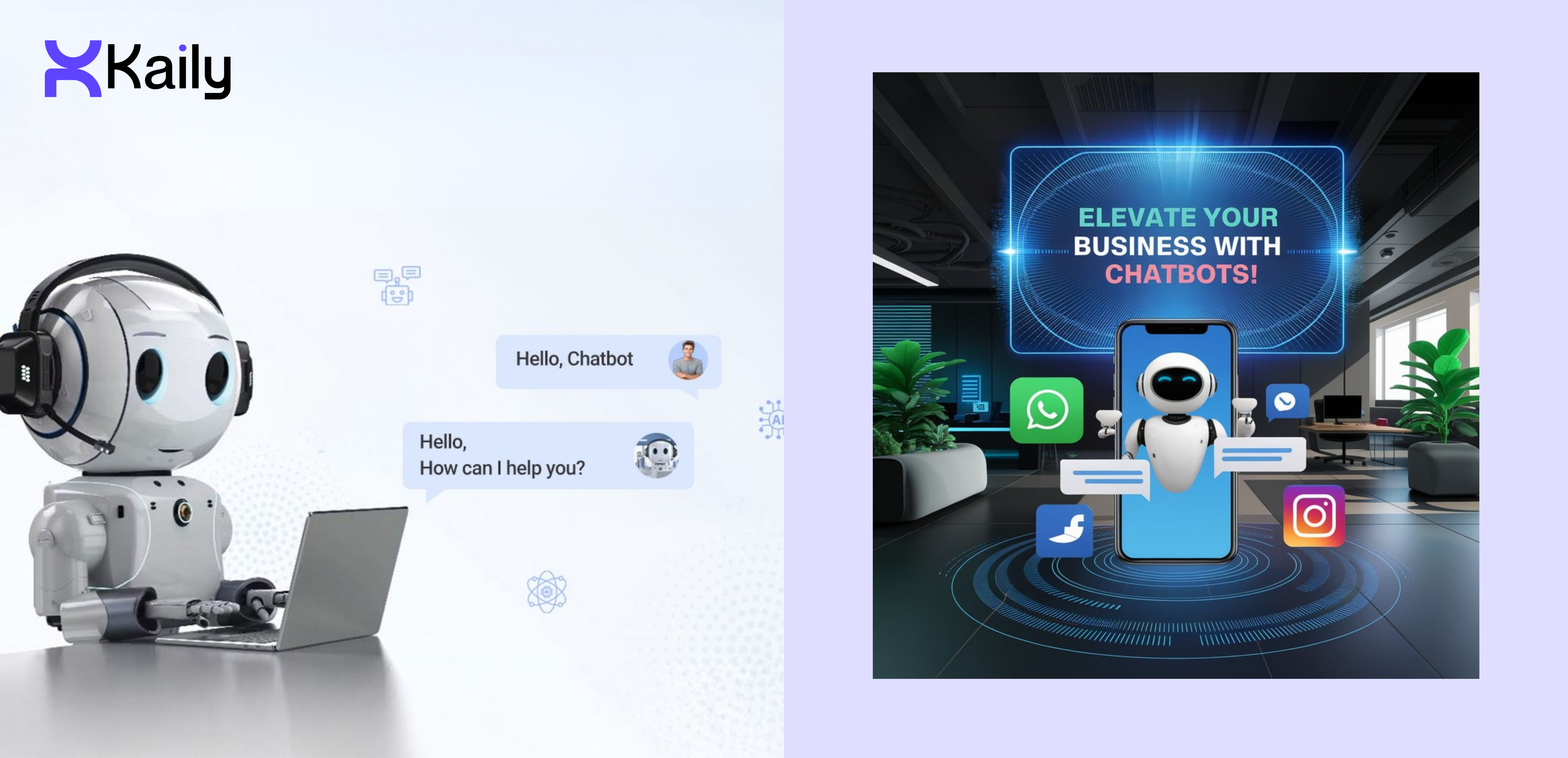A marketing chatbot is a conversational AI-driven tool that engages with customers, automates marketing processes, and improves interactions between customers in digital communication. In contrast to the outdated chatbots, which use fixed scripts, marketing chatbots use conversational AI and automation to provide individualised, context-sensitive interactions, fueling lead generation, nurturing and support of customers in real time.
Marketing chatbots enable businesses to react to inquiries immediately, prequalify leads, suggest products, and gather valuable information without the need for human involvement through the use of natural language processing (NLP) and behavioural data.
How Does a Marketing Chatbot Work?
Marketing chatbots act as intelligent agents between the customer and the brand. They operate in three layers: intent recognition, data processing, and automated response generation.
- User Interaction: The user provides the chatbot with an input, which can be a question or a command.
- Intent Recognition: It recognises the intent and the context of the user using NLP.
- Response Generation: It generates a suitable response based on pre-written logic or trains an AI to respond in a certain way or initiate a particular marketing process.
High-tech chatbots are compatible with CRM, analytics, and marketing automation systems. This allows them to:
- Capture lead data in real-time
- Target audiences according to behaviour
- Activate customised campaigns (emails, product recommendations or surveys)
- Map customer profiles with the sync data to be used in the future
As an example, a chatbot on a retail site operated by AI could welcome a visitor to the site, inquire about their tastes, and suggest products just like a salesperson does in a store.
Chatbots improve their precision behind the scenes with machine learning. When users ask questions, the chatbot retrieves and analyses thousands of previous conversations and fine-tunes its intent recognition. This process begins to enhance customisation to make sure the responses are more pertinent in the future.
In addition to conversing with users, chatbots perform tasks such as sending data to a CRM, setting up a meeting, or starting a follow-up email. This means chatbots execute actions as well. Marking chatbots built on HubSpot, Salesforce, and Mailchimp technology entirely automate the process of engaging and responding to user-initiated actions as part of marketing automation.
Benefits of Using Marketing Chatbots

Chatbots in marketing are changing the way businesses interact with people and simplify their marketing processes. Their benefits are in terms of visibility, conversion and retention.
- 24-Hour Access and Real-time Relationships: Chatbots are available 24/7, and therefore, visitors will always receive a real-time reply, even when out of business. Such immediacy increases user satisfaction and precludes possible drop-offs.
- Generation of Leads and Qualifications: Chatbots will be able to welcome visitors, pose questions to qualify them, and gather information such as name and email address or company size. They will be able to automatically identify leads and direct the high-potential ones to sales teams.
- Personalisation at Scale: Chatbots will suggest and respond to user actions, historical interactions, and demographics through conversational AI. This will provide a smooth, personalised experience to all visitors.
- Cost Efficiency: Chatbots will eliminate the reliance on huge human teams when it comes to marketing and customer support, automating repetitive processes and saving money without sacrificing the quality of interactions.
- Data-Driven Insights: First-hand customer information gathered through chatbots can be used to improve campaigns, discover customers' popular products, and improve messaging strategies. As an example, marketers can interpret emotional tones in user messages with the help of the Sentiment Analysis tools and alter content.
Additionally, chatbots enhance brand loyalty and consistency. Quick, warm, and precise responses build user trust. They also manage high user traffic, and thus, help companies launch and run promotions during peak season or other times, such as holidays, product releases, or end-of-season sales.
Chatbots also improve multilingual and inclusive marketing campaigns. They use advanced multilingual chatbots to build cross-regional and cross-demographic responsive marketing campaigns. This feature significantly broadens the marketing initiatives, making them more inclusive and responsive to users.
Use Cases and Implementation Examples
Chatbots in marketing can be used in different industries and for various objectives. The following are some typical applications:
- Lead Generation: Chatbots can replace conventional lead capture with conversational lead capture. They can support real-time questions, filter users, and automatically transfer information to CRM systems such as HubSpot or Salesforce.
- Product Discovery and Recommendations: Chatbots are used by E-commerce brands as a way of recommending a product, selling more or telling someone to take a discount based on what they browse.
- Event Marketing: Chatbots are utilised to register people at events, send schedules and reminders, and create a personalised pre- and post-event experience.
- Customer Education and Onboarding: Bots are applied to SaaS and B2B businesses to guide new users through the steps of the setup, indicating the features or referring to the resources.
- Online Marketing campaign: Interactive campaigns, i.e. quizzes, surveys or giveaways, can be performed with the help of AI chatbots in order to make the process more interesting and involving.
To illustrate, one of the applications of chatbots can be seen in a travel company advising visitors through the booking process, suggesting destinations, and even upselling travel insurance. Equally, an educational platform can integrate chatbots to respond to questions on courses, give study materials, and receive feedback on their experience.
Key Features to Seek in Marketing Chatbots

Marketing chatbots have differences in capabilities. The features that are important and help in deciding which ones to use are as follows.
- No-Code Bot Builder: A no-code chatbot builder is a tool which allows a marketer to create and deploy chatbots without the assistance of chatbot developers.
- Multichannel Deployment: To ensure that brand experiences are always the same, be sure that the chatbot can run on websites, WhatsApp, social media, and email.
- Conversational AI Capabilities: Advanced Natural Language Processing and Sentiment Analysis to converse with users just like a human being, and is not limited to pre-programmed policy-based responses.
- CRM and Analytics Integrations: The automated workflows will be smoother when combined with CRM, such as HubSpot, Salesforce, or AI Helpdesk, as it will ensure that data consistency happens.
- Personalisation Engine: The best chatbots will be able to tailor responses immediately based on the history of the interaction and the profile information of the customer.
- Security and Compliance: Select chatbots which process data safely according to GDPR, especially user profiling and analytics.
Alongside them, such issues as chatbot scalability and the ease of maintenance should be included in this list. Testing sandboxes and visual design tools are much better at accelerating deployment. As an example, user-flow and drop-off gap analytics dashboards can allow your teams to optimise engagement and conversion as time progresses. The functionality of chatbots can be enhanced with AI that will automate various elements, such as tone, message customisation, and other features, to complete an intent and maintain a consistent brand.
How to Choose the Right Marketing Chatbot?
Your organisation's size, goals, and available technical resources will dictate the type of chatbot system that will deliver the best returns. Follow this strategy.
- Define Objectives: Determine whether your priorities are automating support, lead capture, or improving conversion.
- Evaluate Capabilities: Compare natural language processing, analytics, and integration flexibility.
- Assess Ease of Use: Select systems that have clear dashboards and require little technical configuration.
- Test for Scalability: It should handle growing traffic and support multi-language use.
- Check Pricing and Support: A sound system will balance what you pay and what you get in terms of customisation and after-sales support.
Before choosing a platform, it's a good idea for companies to run pilot campaigns to see how chatbots function in the real world. You want tools that enable making iterative modifications without the need for coding. Also, look at engagement measures like click-through rates, session duration, and lead conversion, to name a few.
It helps to assess the reliability of your vendor, too. Frequent improvements, acknowledgement of customer support, and standards for data security can all make a difference in the long run. Your ideal chatbot must adjust to your marketing strategies and seamlessly integrate into your current technology suite.
Future Trends: Conversational AI in Marketing
Conversational AI will lead the next stage of marketing automation. Future chatbots will provide intelligent, empathetic, and predictive interactions, surpassing simple scripted dialogues.
- LLM-Driven Chatbots: The integration of Large Language Models (LLMs), enabling contextual understanding, multi-turn memory, and nuanced responses, will push chatbots to mimic human interactions more closely.
- Voice and Multimodal Interfaces: Voice-activated marketing chatbots will improve marketing engagement and accessibility across various devices.
- Predictive Personalisation: Proactive AI systems will suggest products and actions based on user behaviour even before customers articulate their requests.
- Sentiment and Emotion Recognition: Real-time mood detection systems will allow brands to assess and alter their emotional tone to the audience.
- Unified AI Ecosystems: As chatbots integrate more with AI analytics, content generation, and customer insight systems, the marketing automation stack will become unified.
Chatbots are becoming central figures in managing customer connections and integrating the components of selling and servicing the customer. Companies will come to depend on these chatbots to evaluate intent across different lines and deliver customised campaigns in real time as the user's behaviour shifts.
The advancement of legislation on AI and ethical practices will facilitate the abstraction of chatbots toward managing digital interactions. This enhancement will transform digital marketing and redefine the role of chatbots in customer interactions from basic communication to high-level collaboration in orchestrating the user journey.





